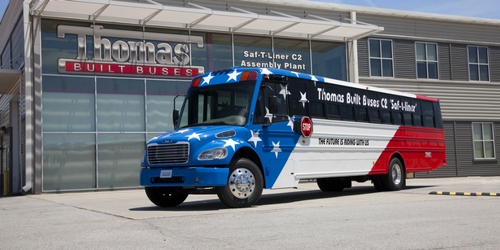
Only two countries in the entire world transport students to and from school via a school bus: the United States and Canada. School buses are the largest system of mass transportation in the United States, transporting nearly 25 million students daily. Even with its large numbers, school buses remain the safest way to get to and from school.
The National Highway Traffic Safety Administration estimates that students are 70 times more likely to arrive at school alive if they take the bus versus driving themselves or riding with friends.
To ensure students’ safety, we at Thomas Built Buses produce school buses to meet more than 42 federal motor vehicle safety standards – the most in any industry. School buses are required to meet higher construction, equipment, and inspection standards than any other vehicle and school bus drivers are required to meet higher qualifications, training, and testing standards than any other drivers on the road.
Never one to stop at meeting government requirements, Thomas Built Buses has developed many firsts and innovations that have helped to shape the school buses of today to go above and beyond since our founding 100 years ago. In 2004, we added a 275,000 square-foot, state-of-the-art plant in High Point to manufacture the revolutionary Saf-T-Liner® C2. The C2 rocked the industry as the first conventional bus designed from the ground up for superior durability, reliability, and safety. Today we make over 50 of this model per day.
More recently, our buses can come equipped with a number of new state-of-the-art safety features, such as our new PV360 camera (a 360-degree exterior camera), stop arm cameras, land departure warning systems, and collision mitigation systems.
It’s easy to see why the yellow school bus has become an American icon. And we are proud to be the leading school bus manufacturer that is leading the way for safer, smarter, more efficient school buses tomorrow and well into the future.
Recently I was riding a shuttle bus at the airport along with five other people. The moment the bus pulled away from the curb, all five people had their cell phones out and were “connected” to somewhere else altogether. I observe this behavior a lot; perhaps you have as well.
Read MoreLike a plant in a garden, the working culture of a manufacturing plant also needs nurturing. The challenges of keeping employees working productively and the plant running smoothly are typically unique to the manufacturing world. During my 26 years with Daimler Trucks North America I have ridden the waves of business fluctuations, and I have had the opportunity to play a key role in keeping the culture and comradery evolving to keep engines and trucks rolling down the production lines.
Read More